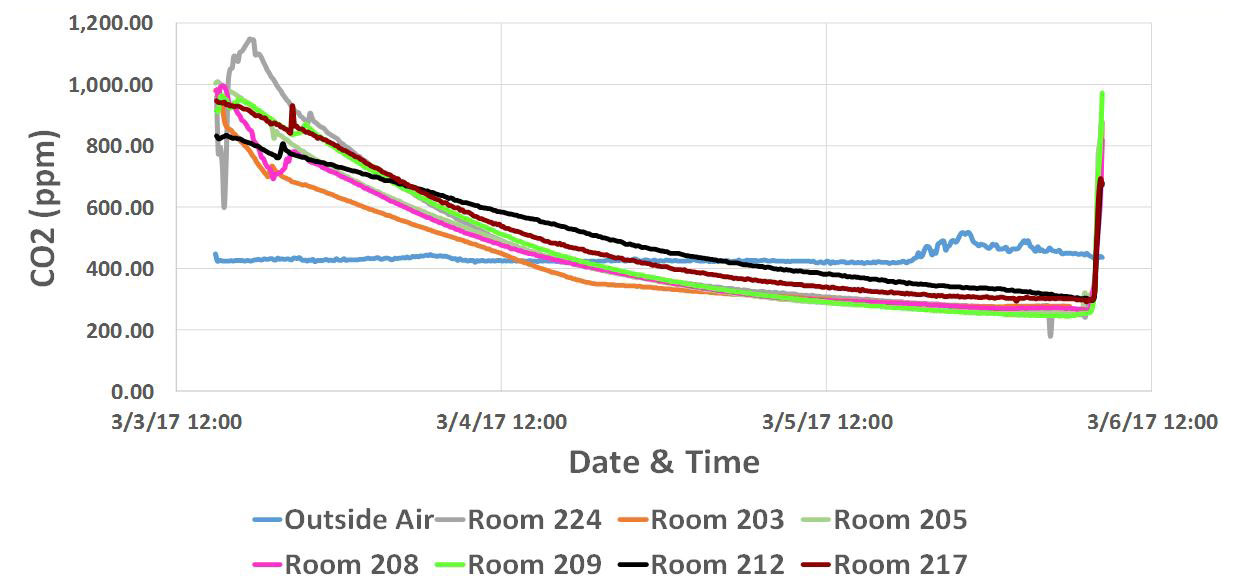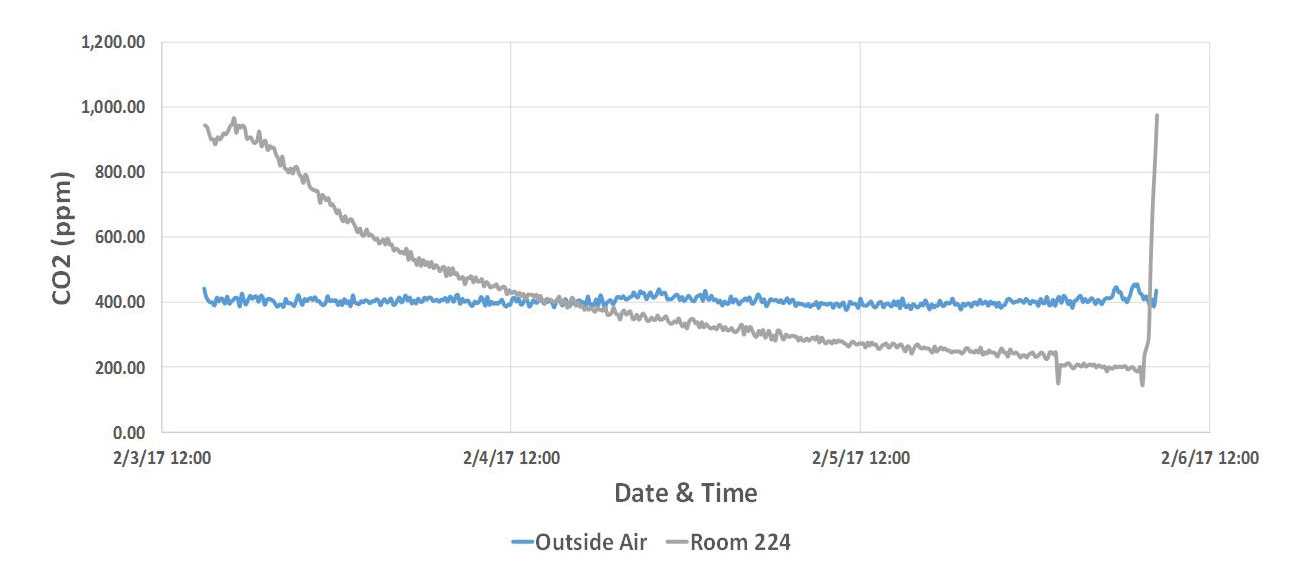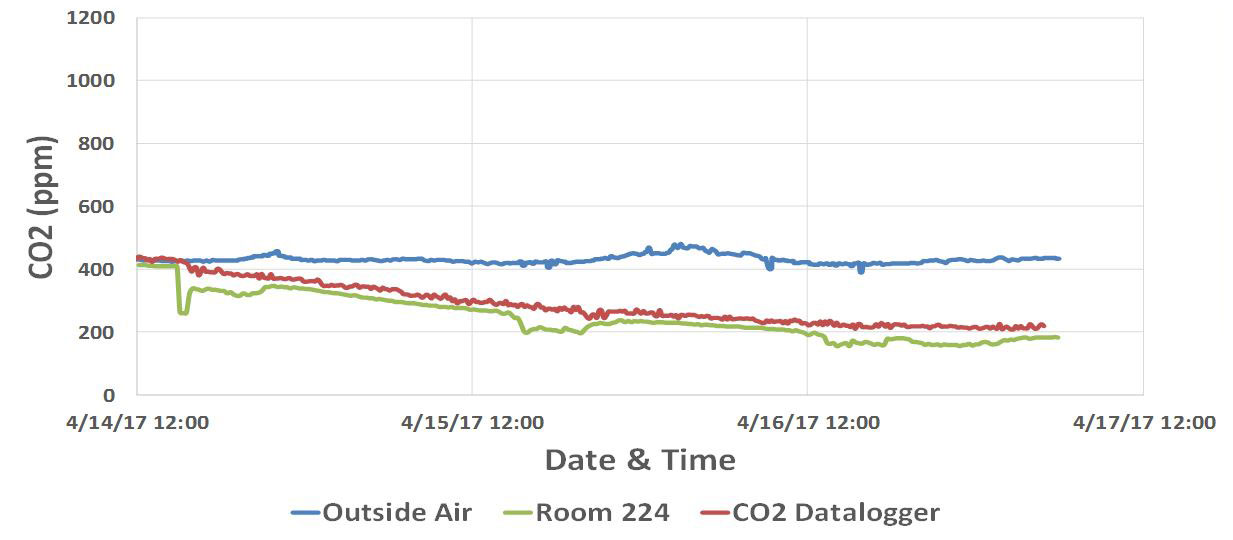Howard County Public Schools set out to construct a 106,221 square foot net zero energy (NZE) middle school to replace an aging facility. The new building was designed to accommodate twice the student population while using half the amount of energy. In addition to the goal of being the first NZE school in Maryland, the project team was targeting a LEED® certification.
James Posey Associates (JPA) worked closely with the county to include just the right combination of energy conservation measures and renewable features in the design to reach a NZE use. Reducing demand is the first step in achieving net zero, and Aircuity Channel Partner, Metropolitan Equipment Group (MEG), worked with JPA to design Aircuity into the project. Aircuity was selected for the project due to its accuracy and reliability in measuring building carbon dioxide levels. When coupled with the school's demand control ventilation design, the Aircuity system helped to ensure that the required quantity of outdoor air was delivered to each space while meeting the NZE goals. Aircuity was installed in all classrooms and assembly areas before the school’s completion in January 2017. The project not only was on budget and Maryland's first NZE school, but it was also LEED Platinum Certified and one of the most energy conscious schools in the nation.
“Wilde Lake Middle School initially used a combination of occupancy sensors and the Aircuity CO2 readings to control the ventilation in our building. We soon ran into a series of issues with the occupancy sensors,” said Tim Heinrich, HVAC project manager, Howard County Public School System. “Meanwhile Aircuity validated the sub-ambient indoor CO2 levels that were measured in the classrooms. We have since disabled the occupancy sensors and put our full trust in the accuracy and reliability of our Aircuity system.”
Identifying the Cause of Abnormal Carbon Dioxide
After the building opened in 2017, Howard County personnel noticed something unique happening — after school ended on a Friday evening and through the duration of the unoccupied weekend, Aircuity's data showed carbon dioxide (CO2) levels within a classroom space dropping below ambient conditions while rising back up as students and staff returned on Monday morning (Figure 1).
MEG went to work trying to figure out the cause. Initially they thought it was a faulty CO2 sensor, and the sensor was swapped out. The CO2 readings were reviewed to see if the issue was resolved; however, the indoor readings were still falling below ambient. In addition, data from other classrooms were checked and found to be exhibiting the same behavior, with CO2 levels dropping below the outside air conditions (Figure 2). Next, they wondered if it was due to a kink in the tubing. However, with multiple rooms falling to nearly the same CO2 offset below ambient, and Aircuity being a centralized sensing technology, kinked tubing was deemed highly unlikely.

Click figure to expand
FIGURE 2: Checking initial solutions and occurrence in multiple rooms, March 2017
Aircuity’s centralized sensing architecture and reliable sensor technology ruled out a number of traditional causes of CO2 reading errors, such as sensor drift. This provided MEG the confidence to suggest the possibility that CO2 in the classrooms were indeed dropping below ambient. A third party CO2 datalogger was installed in one of the classrooms beside the Aircuity sample port and data was gathered over an unoccupied weekend. The datalogger test results validated the Aircuity system’s readings (Figure 3). Note that while the time scale shows the same noon Friday to noon Monday time period as the previous graphs, the initial peak in the classroom CO2 levels for both the datalogger and Aircuity values begins much lower, at roughly ambient levels. Checking the calendar for Friday, April 14th, 2017, revealed that this was Good Friday and that Wilde Lake Middle School was closed for the holiday. As a result, the classroom had begun its unoccupied CO2 level decline at least a day earlier on Thursday and from a reduced occupancy level, as the students were off that week for Spring Break and only staff and faculty would have been present on Thursday.
After seeing the results of the datalogger test in addition to watching the data and occupancy closely, Howard County's confidence in the accuracy of the data provided by Aircuity was restored.
Aircuity and MEG searched for potential explanations for this counterintuitive indoor air condition. The simplest option, high indoor vegetation density, was quickly ruled out as few indoor plants were present in the building. Further investigation yielded one of the most likely explanations, indicating that the unusual conditions could have been caused by the carbonization of concrete. According to academic research*, “As CO2 comes in contact with a concrete surface, the calcium hydroxide in the concrete reacts with carbon dioxide in the air to form calcium carbonate.” With Wilde Lake being an NZE building, it had a very tight building envelope, and the installed DOAS unit was turned off during unoccupied times.
Additionally, being a K-12 project meant that the building would have long, unoccupied periods when school was empty during the weekends. In this type of environment, small effects on indoor air quality (IAQ) can build up and appear magnified compared to what is traditionally thought to be possible.
The probable culprit was identified, and as the cement continues to cure over time, CO2 levels should start to level out closer to ambient. The case of Wilde Lake Middle School identifies new IAQ conditions that need to be considered in future construction projects, especially where tighter building envelopes are being used to meet energy goals or stricter code requirements. Aircuity can help identify and address the undiscovered IAQ conditions that may develop inside future buildings.
“The accuracy, reliability, and local support offered by Aircuity was an important design consideration, especially towards sustaining net zero energy throughout the operating life of the school,” said Mike Sherren, P.E., vice president, James Posey Associates.
By Sarah Callahan, Aircuity. *Source: Lopez, Ashley Lane. Carbon Dioxide Absorption by Various Types of Pavement Binder Materials
Submit your own guest content here!




Report Abusive Comment